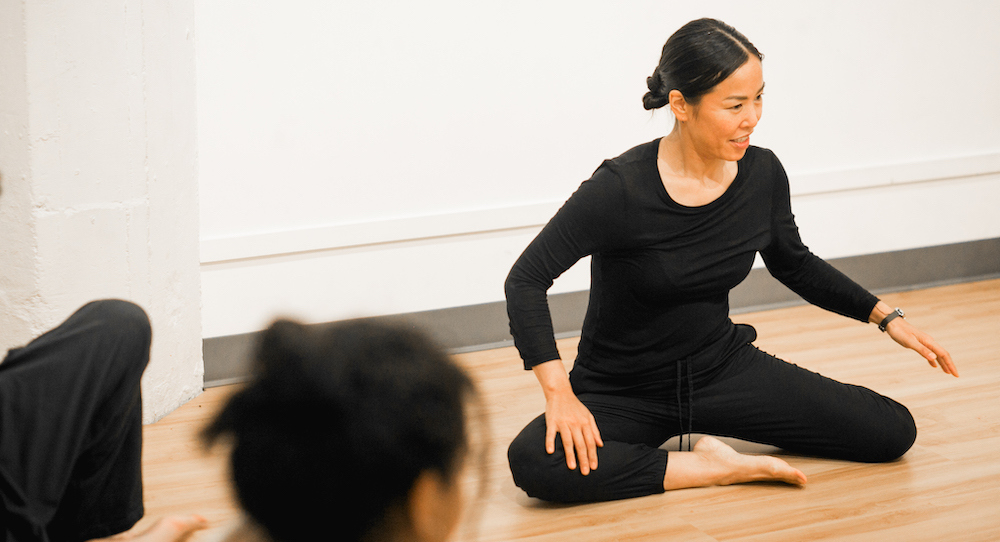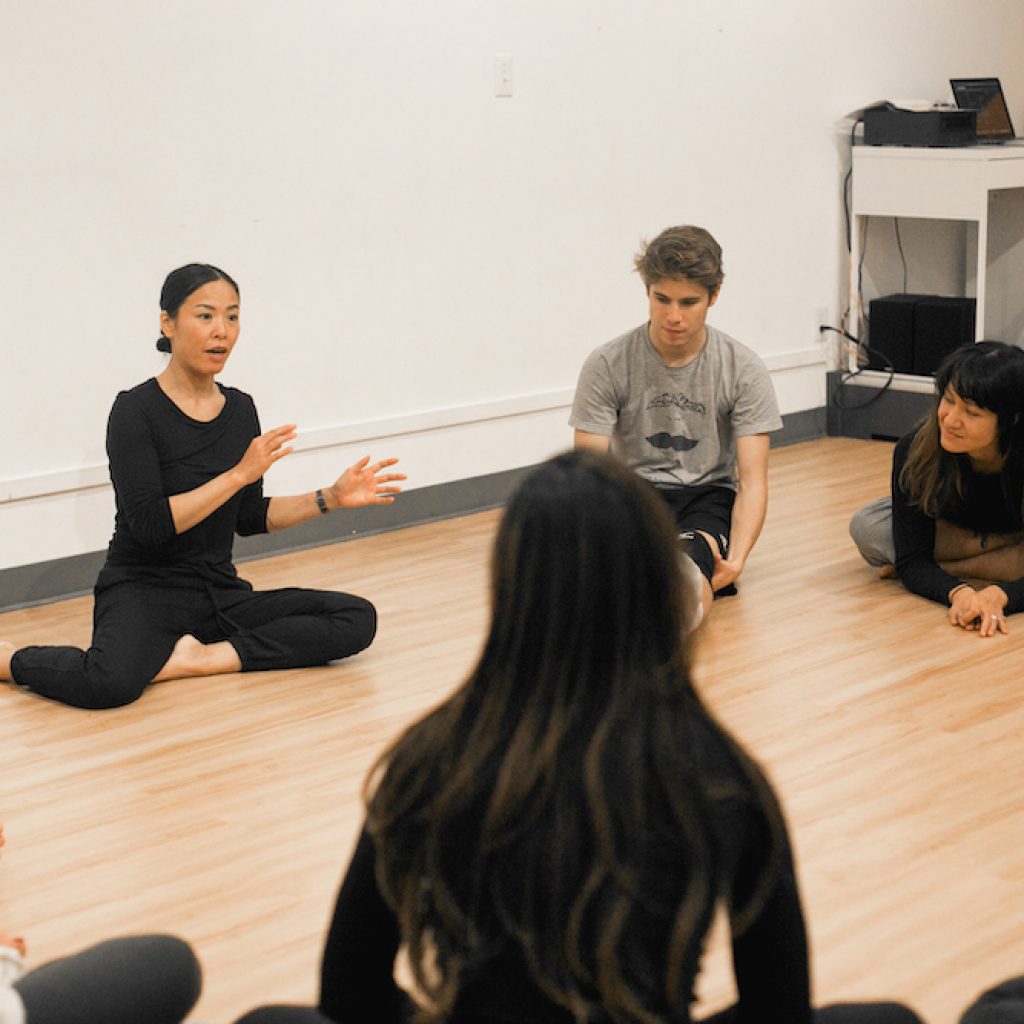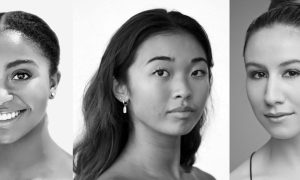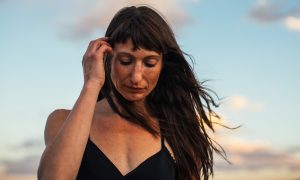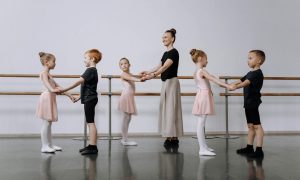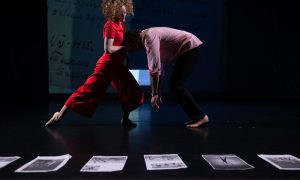Kana Sato is an original founding member of Shen Wei Dance Arts. Sato is from Japan, and attended CalState University for dance. Upon graduation, she was offered a scholarship to American Dance Festival, where Shen Wei was a guest artist. At the end of the summer, he invited her and others to join a company he was forming in New York, which became her dance home for a decade. It’s the story of a successful dance career – but she’s shifted paths since then.
“When I was leaving the company,” says Sato, “I transitioned into teaching Pilates, but there was something missing. I missed dancing. I missed the performance aspect of it, but my body was getting older, and I knew that physically I wouldn’t be able to do the same kind of performance as I did. I thought maybe I could do acting. So I signed up for a two-year conservatory with the teacher Terry Knickerbocker, who’s my boss now.”
Sato is now a movement teacher at Knickerbocker’s acting studio in Brooklyn. Of the conservatory program, she says, ‘It really changed my life. I rediscovered who I was. At the end of the two years, I was hooked.”
She continues, “After that, I did some acting here and there, but I really loved witnessing personal growth in my peers, and kept going back to (Knickerbocker’s) scene study classes for four or five years. At that point, Terry was building his own school. He knew about my extensive dance background and asked if I wanted to teach movement. That’s when I started to shadow my mentors and co-teachers Nathan Flower and Julia Crockett, who are still residents at the studio.”
Sato mixed her dance background with new artistic input – Williamson technique, a physicality-based acting approach that she now teaches. “Even though I took a semester of this technique while in the conservatory, it never really clicked for me. But as I was studying under Nate and Julia, I was discovering how deeply effective it could be for an actor to discover themselves through movement. Almost in an opposite way from how we learn our bodies as dancers. As dancers, we train ourselves to be our best versions onstage, to endure pain and discomfort. We train and train to be the best. Often the actor training, at least at the basic level, is to undo the habits that we keep to protect ourselves. The goal is to be messy, imperfect, human.”
Dancers and actors are both artists, but we speak different languages. “As a dancer, we cultivate this presence onstage, through motion or stillness, owning the space. That translates well whether on stage or on screen. What doesn’t translate is some of the armoring, the habits that help us ‘keep it together.’”
As dancers, it’s not our physical training that lends itself to acting. In fact, the rigidity of that training often needs to be undone in order to find the natural physicality of a character. It’s our awareness of and interest in physical exploration that’s our strength.
“When a dancer has that hyperawareness in the subtle details, and their instrument is malleable and specific, that can be helpful. Dancers who know how to make physical choices are instantly watchable. And yet, dancers (myself included) are so used to doing something without safety or comfort in the body. They endure such discomfort physically, and I think it translates emotionally and psychologically. But human beings are wired for safety and comfort; without that, we can’t be curious. For me, as a dancer, I was in denial with the degree of discomfort I was experiencing, while pushing through it. But as an actor, we need to be aware that when you are uncomfortable, you are not embodied. The somatic, mind-body connection is crucial.”
They’re two different skills. Dancers have the ability to endure discomfort, all the way up to levels of pain, and still dance. But if actors try to push through discomfort, their performance won’t read as natural. It might come off as stiff, or awkward.
Sato also notes that dancers can be very independent in their craft – most of your training is spent focusing on your own body and performance. In theater style dance, dancing with a partner or group is secondary, and even then that interaction is choreographed and consistent. Whereas acting is all about interactions between people. Scenes require you to collaborate, responding to a partner’s evolving input. The most comparable example in dance might be a structured contact improv.
Sato underlines the sense of community that acting and Terry Knickerbocker Studio has brought her, of a variety that she hadn’t felt in dance company life. The ability to foster that safety and closeness (and do so quickly) is not only part of actor culture, it’s part of the job. Being thrown onto set with an actor you’ve barely met and doing an emotionally connected scene with is a skill.
Dancers absolutely bring their own strengths to acting; we just also need to be aware of our habits. For those looking to make the shift to acting, or add it to their long list of skills, it may take some translation of your existing artistry. It might require rewiring your responses to discomfort, unworking some perfectionism, uprooting the pride that hides in independence, and opening up to others in a new way.
“My first passion, still my passion, is dance,” says Sato. “And it has fueled me for decades. And – I feel my life is so much richer now through (acting) training and in this supportive role. I love teaching. I do not regret taking this path, not an ounce. If anyone is thinking about transitioning into acting, or adding acting training to their dance training, it’s fantastic.”
By Holly LaRoche of Dance Informa.


